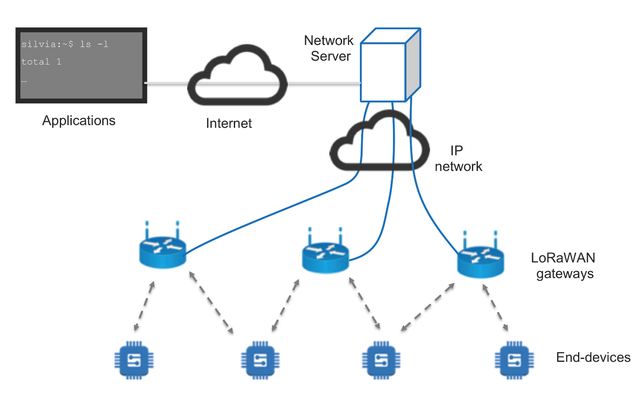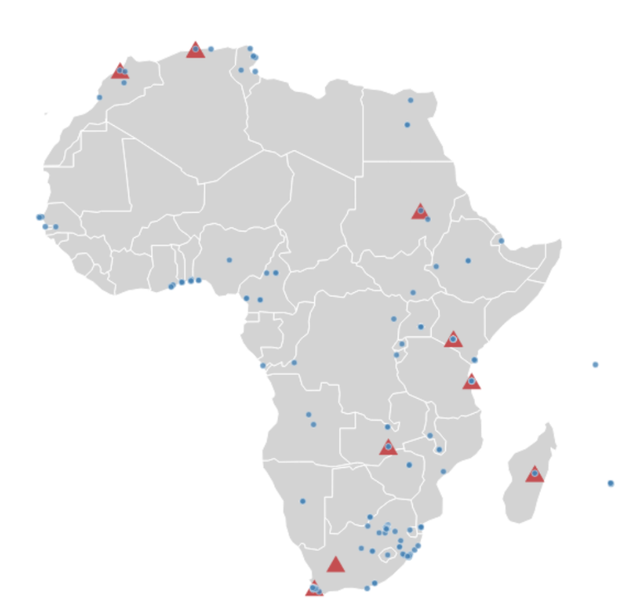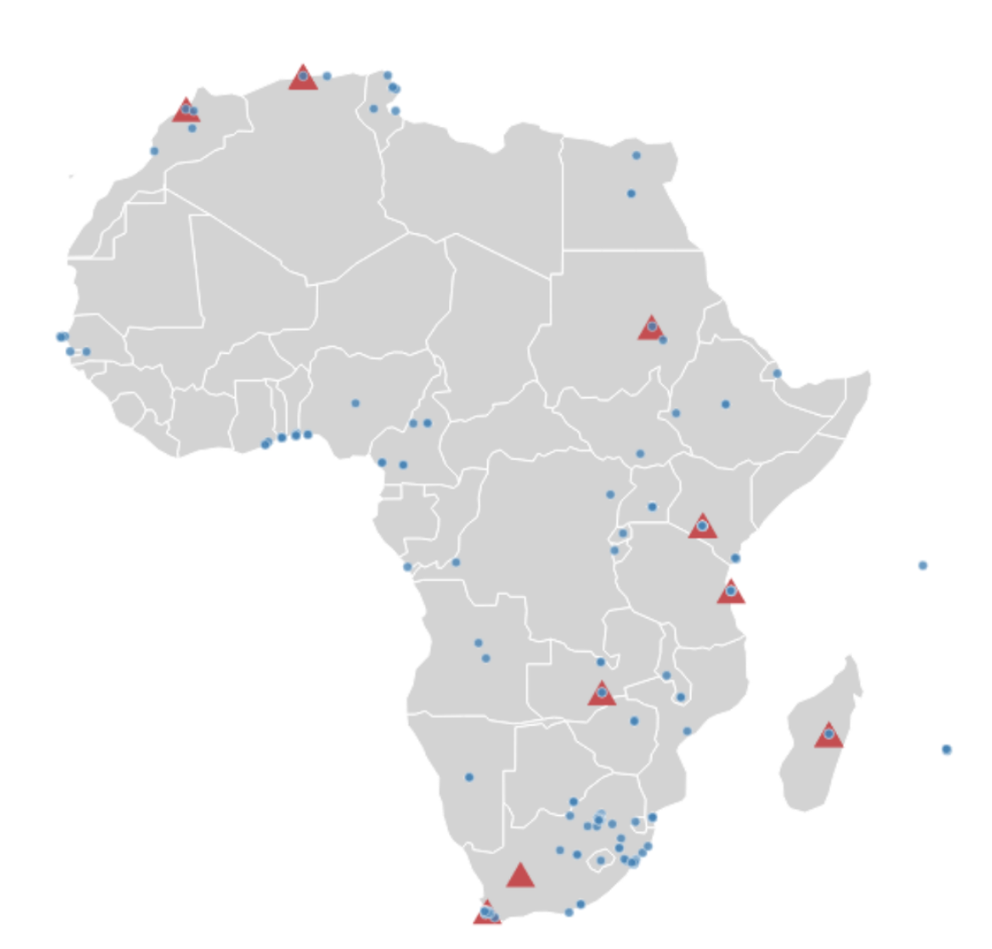We analysed the readiness of African National Research and Education Networks (NRENs) to be part of “The Things Network” (TTN). We used RIPE Atlas to measure delay and packet loss from NREN networks to TTN.
The Things Network and LoRaWAN
The Things Network (TTN) is a network of IoT gateways that has fostered the growth of IoT in Europe by adopting a community network model. It is an initiative to build a worldwide open source infrastructure to facilitate a public Internet of Things (IoT).
TTN is based on LoRaWAN, a Low-Power Wide-Area Network (LPWAN) protocol that can be used to build IoT networks. LoRaWAN provides low-bandwidth communications over long distances. The LoRaWAN specification is developed and maintained by the LoRa Alliance, an open association of collaborating members. In typical applications, IoT nodes send few bytes of data every few minutes/hours over distances in the range of 1-10 kilometres. These technical characteristics allow the use of cheap devices that can last five to ten years on a single battery. TTN operates by allowing users to share the access to gateways, which play the role of access points for LoRaWAN networks. As the amount of traffic generated by nodes is very limited, users are willing to share the access to their gateways and this allows the network to have a greater coverage. The cost of LoRaWAN gateways is not the largest problem when setting up a new local IoT network. Finding the locations to install the gateways is the biggest obstacle. This is where NRENs can play an important role as they have locations spread all over cities. There are now over 300 TTN communities worldwide, in more than 100 cities. TTN offers an opportunity to bring academic communities and businesses together by creating an open ecosystem.

Figure 1: The LoRaWAN architecture
The need for NRENs
NRENs are being deployed to address the specific needs of the Research and Education communities in terms of bandwidth, quality of service, security, and reliability. These needs cannot typically be met by commercial providers since they would require high costs with possibly low economical returns. These types of network are becoming really helpful in tackling the digital divide between academic and research institutions in different geographical areas. They provide the possibility to train academic staff and attract young scientists, which the country needs for stimulating its national research agenda. NRENs also offer the possibility to participate in international projects and therefore to access state-of-the-art facilities particularly in domains with development potentials. The NRENs Community involves Universities, Research and Development Institutions, Primary and Secondary Schools, Libraries, Museums, Hospitals, Telecom Service Providers and Internet Exchange Points (IXPs). The Major Global NREN Clusters are GEANT, TEIN3 and Internet2.
The first step for the establishment of NRENs in Africa can be tracked back to the deployment of undersea fiber optic cables along the East and West coasts of Africa in the last decade, improving Internet connectivity in several countries. Over the last few decades many African countries have established their own NRENs and had them connected as a continental wide network through an initiative called the Africa Research and Education Network (AfREN). In the last decade, regional associations of NRENs have been formed to promote the AfREN concept, UbuntuNet Alliance, in Eastern and Southern Africa, and WACREN in Western and Central Africa.
RIPE Atlas TTN Measurements
Thanks to the RIPE NCC's support we were able to schedule an experiment to measure the round-trip-time (RTT) from 216 RIPE Atlas probes in Africa to the TTN network server in Ireland every 15 minutes. This TTN network server is used by African TTN nodes as there is no server on the continent. The same network server is used by European TTN users. The experiment started in November 2018 and gathered data up to July 2019. Figure 2 shows the locations of RIPE Atlas probes in Africa involved in this experiment.

Figure 2: NREN (red triangles) and non-NRENs (blue circles) probes
In this preliminary analysis, we focused on data collected in December 2018 in African countries where both NRENs and non-NREN probes could be identified. We wanted to compare TTN access from academic and commercial connections. We identified probes being installed at the following NRENs:
- Algerian Academic Research Network
- Kenya Education Network
- Moroccan Academic and Research Wide Area Network (MARWAN)
- Research and Education Network for Academic and Learning Activities (iRenala), Madagascar
- Mozambique Research and Education Network (MoRENet)
- Sudanese Research and Education Network
- Tanzania Education and Research Network
- Tertiary Education and Research Network (Tenet), South Africa
- Zambia Research and Education Network (ZAMREN)
Of all the probes hosted in Africa, we could only use the data coming from eight countries where we were able to identify probes in both academic and commercial networks. About 350,000 traceroute commands were run in the month of December 2018 in the eight countries of interest. Figure 3a below shows the RTTs per country and NREN membership computed using the mean value of RTTs coming from the probes, where each measurement consisted of three packets. In Figure 3b we show the packet loss per country and NREN membership, in the eight countries under consideration.

Figure 3a: RTTs median (circle), first and third quartiles (bars) for NREN (red) and non-NREN (blue) probes and 3b: Packet loss for NREN (red) and non-NREN (blue) probes
We observed that the RTTs are often similar from NREN and non-NRENs probes with a few exceptions such as Kenya. On the other hand, packet loss is often higher in non-NRENs except for Madagascar. To ensure the reproducibility of our research and to disseminate the techniques and tools used for the analysis, a companion Python Jupyter Notebook containing the whole data analysis pipeline, is available publicly.
Conclusions
In this study, we distinguished RIPE Atlas probes hosted in NRENs from those with a commercial Internet access. This was mostly a manual task and we identified the need to tag measurement infrastructure with accurate meta data. We then observed that the RTT was not significantly different between the two classes of providers - academic versus commercial - in most countries. In the eight countries under consideration, the RTT values would not impact the access to TTN. Packet loss is not significantly high and is not distinctive between NRENs and commercial ISPs for most countries and both classes of networks seem to converge to similar performances. In two of the eight countries, however, the packet loss is significantly higher in commercial networks compared to the academic ones.
We noted the low number of RIPE Atlas probes on the African continent. This has an impact on the generality of our findings. To draw conclusions with a higher confidence we need more sources in Autonomous Systems both commercial and academic.
Future work and suggestions
The current study relies on RIPE Atlas built-in measurements. We did not generate additional measurements. In the future, we plan to measure at higher rates in order to determine losses with higher accuracy. We suggest adding tags to probes in measurement infrastructures in order to ease studies such as this one. RIPE Atlas already indicates the hosting country, the latitude and longitude of probes, as well as their address type (IPv4 and/or IPv6). We suggest adding information about the type of provider: commercial or academic. If the RIPE Atlas probe is connected to a commercial ISP, a label with its rank in the Internet hierarchy would also be helpful. Most researchers rely on the CAIDA AS ranking data set for this purpose. An integration of this information would help reproduce past studies and run them longitudinally. A tag indicating if the probe is connected to a network serving IoT gateways would also be very helpful.
For more information, please refer to the full paper.


Comments 0
The comments section is closed for articles published more than a year ago. If you'd like to inform us of any issues, please contact us.